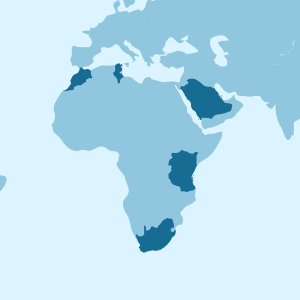Taxes in Germany vs Spain: Which should I pay?
We compare taxes in Germany vs Spain. Want to know which country would mean lower taxes for you? Discover the key differences in tax rates and obligations.
When moving or setting up a business abroad, taxes are often a major concern. Taxes in Germany vs Spain are complex, with significant differences in rates and obligations for residents and companies. These differences can impact your finances, especially if you plan to live or run a business in either country long term.
With this article, we want to go through the differences between the tax systems in both countries. We will review personal and business tax rates, available deductions, and how each country approaches tax payments. By the end, you’ll have a complete overview to help you decide which of the two destinations might be more beneficial for your tax interests.

Taxes for businesses or legal entities
Are you thinking about starting a business in Europe and can’t decide between Germany and Spain? You’ll be pleased to know both countries offer tax systems that aim to attract investment and foster economic growth. However, differences in structure and tax rates can impact a business’s profitability and operational costs. Differences in structure and tax rates can impact a business’s profitability and costs. Let’s compare taxes in Germany vs. Spain, focusing on those that most affect businesses, and explore the tax benefits each country offers, especially for new businesses in emerging and tech sectors.

Corporation Tax in Germany vs. Spain
One of the most important taxes when choosing a country to establish a business is corporation tax. This tax is levied on corporate profits and is one of the main tax burdens for any business. The tax rates and structures in Germany and Spain vary considerably. This affects not only competitiveness but also the financial sustainability of a business in each country.
- Germany: In Germany, corporation tax (Körperschaftsteuer) has a flat rate of 15.38%. In Germany, a 5.5% solidarity surcharge is applied to corporate tax, significantly increasing the overall tax burden. There is also a local trade tax (Gewerbesteuer), which ranges from 7% to 17% depending on the municipality. The effective tax rate for businesses in Germany typically ranges from 22% to 32%, one of the highest in Europe. However, Germany offers specific R&D deductions, though its incentives are less extensive than in other European countries.
- Spain: Spain applies a standard corporation tax rate of 25%. However, new businesses can benefit from a reduced rate of 15% during their first two years of profitability. Spain also offers significant deductions for R&D&i projects, with tax reductions of up to 42% for research and technological innovation projects. This support for startups and tech companies makes Spain an attractive destination for innovative sectors.
Germany offers a fixed rate with a higher tax burden, while Spain incentivizes new businesses and innovation with reduced rates and R&D&i deductions. Tech or emerging sector companies may find a favourable tax environment in Spain during their early years of operation.
Economic Activity Tax in Germany vs. Spain
Another tax that adds an additional burden to businesses is the economic activity tax. This tax applies to commercial, industrial, and professional activities, and is an important factor to consider when establishing a business.
- Germany: In Germany, the Gewerbesteuer or local trade tax applies to all businesses and self-employed individuals carrying out commercial activities in the country. The rate depends on the location, as each municipality sets its own rate. The rate usually ranges from 8.7% to 20.3%. The total amount of this tax is deductible from the corporation tax base, reducing the tax burden for profitable businesses. Companies in rural areas face lower Gewerbesteuer rates, while large cities have a higher tax burden.
- Spain: In Spain, the Economic Activity Tax (IAE) applies only to businesses with an annual turnover exceeding one million euros. The IAE rates vary depending on the type of activity and the geographical location of the business. In urban areas, these rates are higher.
Spain’s IAE is less flexible than Germany’s Gewerbesteuer, as businesses cannot deduct it from their corporation tax base. This significantly increases the total burden for businesses operating in Spain. However, Spain only imposes this tax on businesses with high turnover, which is a benefit for startups or SMEs in the early stages of growth.
Property Tax in Germany vs. Spain
This tax is of interest if your business owns property or plans to invest in real estate. It is based on the cadastral value of each property and is important to consider as it is a recurring and significant cost in some regions. Both countries apply it.
- Germany: Since January 2025, the property tax (Grundsteuer) in Germany is calculated under a reformed system. The base rate is now 0.031% for residential properties and 0.034% for non-residential properties. This is then multiplied by a municipal factor (Hebesatz) that each city or town sets independently. For example, Berlin has adjusted its Hebesatz to 470%. This means the effective rate varies by location, but generally, businesses can expect a tax range from 0.26% to 1%. The good news is that this tax is detractable from corporation tax, which reduces the total tax burden in many cases.
- Spain: The property tax (IBI) in Spain is managed by local councils and is also based on the cadastral value. The general rates range between 0.4% and 1.1% for urban properties, although cities like Madrid have reduced their general rate to 0.428% in 2025. As in Germany, rates vary considerably by municipality. However, in Spain, this tax is not deductible from corporation tax, meaning it represents a fixed expense for the business.
Generally, the property tax in Germany is lower and offers more flexible deductions for businesses. In Spain, the burden is less variable and largely depends on each municipality’s policies.
Important: If you are a frequent traveler and want to stay connected without worrying about expensive roaming or looking for a new SIM at every destination, Holafly’s subscription plans are for you. With a single eSIM, enjoy internet in more than 160 countries for a fixed price and no surprises on your bill. Travel without limits and connect easily and securely! 🚀🌍

VAT on business transactions in Germany vs. Spain
VAT, or value-added tax, is another important factor for businesses selling goods or services. While it’s the consumer who bears the cost, it directly affects the prices of products and services for businesses. Germany and Spain apply this tax similarly, but their rates and exemptions may influence business profit margins.
- Germany: The general VAT rate in Germany is 19%, applicable to most goods and services. However, a reduced rate of 7% applies to essential products and services, such as food, medicine, and cultural products. Intra-EU transactions are exempt from VAT. This helps reduce costs for consumers on basic items.
- Spain: In Spain, the general VAT rate is 21%. Reduced rates of 10% and 4% apply to essential products like food, medicine, and transport. However, in both countries, businesses can benefit from VAT exemption when dealing with other European businesses.
In summary, the VAT rate in Spain is slightly lower than in Ireland. This structure helps ease the burden on everyday goods. If you’re engaging in transactions with other European businesses, both countries allow you to benefit from the VAT exemption.
As you can see, Spain’s VAT rate is a bit higher than Germany’s. This could influence the final price of products and services in certain sectors. If you’re engaging in transactions with other European businesses, both countries allow you to benefit from the VAT exemption.
Other specific taxes for businesses in Germany and Spain
Besides main taxes like corporation tax, VAT, and property taxes, there are specific taxes that may affect businesses in certain sectors or those carrying out particular activities. These additional taxes can be a significant burden and, in some cases, directly influence the viability of specific projects.
- Germany: In Germany, businesses may be subject to additional taxes depending on the sector or type of activity. One of the most relevant is the tax on construction activities, applicable to construction and civil works projects. Additionally, companies operating in areas with high environmental protection levels may be subject to additional rates to mitigate the ecological impact of their activities.
- Another relevant tax in Germany is the electricity tax (Stromsteuer). It applies to companies in the industrial and energy sectors. This tax is levied on electricity consumption and may impact energy-intensive businesses’ costs. However, reductions are available for companies that implement energy-efficient measures and comply with certain environmental regulations.
- Spain: In Spain, one of the most important specific taxes is the Tax on Constructions, Installations, and Works (ICIO). This tax applies to any work or construction requiring an urban planning licence, with a rate of up to 4% of the actual cost of the work. This represents an additional burden for businesses in the construction, real estate, or those planning to develop their own infrastructure.
- Additionally, in Spain, certain activities like tourism have specific taxes. For example, some autonomous communities in Spain apply a tourism tax on hotels and tourist accommodations. This tax varies by region and can represent a significant cost in high-tourism areas such as Catalonia and the Balearic Islands. There are also additional taxes in sectors like mining, and their impact depends on location and regional regulations.
Although these specific taxes do not affect all businesses, they are relevant for sectors like industrial, construction, and tourism. It’s important to consider them when planning investments or infrastructure projects in both Germany and Spain.
Tax Benefits for New Businesses and SMEs in Germany and Spain
Both Germany and Spain have implemented tax incentives to encourage the creation of new businesses, especially for SMEs and startups in technological and innovative sectors. These tax benefits can be decisive for businesses in their early years of activity.
- Germany: In Germany, the tax incentives for startups focus on capital expenditure deductions and benefits for research and development (R&D) companies. Although Germany’s tax deduction offerings are lower compared to other European countries, the support programs for startups include possible exemptions from the economic activity tax in certain regions.
- Spain: Spain offers a broad tax benefits framework for startups, especially in the R&D&i sector. New businesses can benefit from a reduced 15% corporation tax rate during their first two years of profit. Additionally, the innovation projects deduction system allows companies to significantly reduce their tax burden in the early years of operation. Autonomous communities may offer additional benefits, making Spain a favourable option for businesses in their initial phases.
In conclusion, while Germany offers limited tax incentives, Spain stands out for its specific programs for startups and R&D&i deductions, making it a more favourable environment for emerging and innovative businesses.
Taxes for individuals or natural persons
Let’s now look at the taxes in Spain and Germany applicable to individuals. The tax burden on consumption and income can have a significant impact on net income and quality of life, so it’s important to consider when choosing a place to live. The taxes vary in rates and application criteria.

VAT in Germany vs Spain
VAT, or value-added tax, is one of the main consumption taxes that affects individuals. While both countries apply similar VAT structures, their rates and some exemption criteria differ, and it’s important to understand these differences.
- Germany: In Germany, the general VAT rate is 19%, applicable to most goods and services. However, a reduced rate of 7% applies to essential products and services, such as food, medicine, and cultural products. This helps to reduce the cost for consumers on basic items.
- Spain: In Spain, the general VAT rate is slightly higher, at 21%. Reduced rates of 10% and 4% apply to basic products such as food, medicine, and some social services. This structure helps reduce the burden on essential goods.
As you can see, although the general VAT rate in Germany is slightly lower, Spain offers a greater differentiation of reduced rates for essential products.
Germany vs Spain: Where is personal income tax lower?
Personal income tax is another decisive factor when choosing a country to live in, as it directly affects net income and savings capacity. In both countries, this tax is progressive: Rates increase with income, although the structure and brackets differ significantly.
- Germany: In Germany, the income tax is progressive with an initial rate of 14% increasing up to 45% for incomes over €277,826 ($293,714) per year (for individual taxpayers). Additionally, a solidarity surcharge of 5.5% is applied on the tax amount, which can make the tax burden higher for high-income earners. However, there are deductions and exemptions that help reduce the burden for families and individuals with specific expenses, such as those related to education or health.
- Spain: In Spain, the income tax (IRPF) is also progressive but with a more complex structure. Rates range from 19% for the lowest incomes to 47% for incomes over €300,000 ($327,000) annually.. Each autonomous community has the authority to adjust the IRPF brackets, meaning the tax burden may vary depending on your region of residence. Spain also offers specific deductions for family situations, such as children or disability, which help reduce the tax burden in some cases.
So, while Germany offers a tax structure with fewer brackets and a more straightforward system, Spain has more variability based on the autonomous community and allows for personalized deductions. For those seeking more predictability in their tax burden, Germany might be a simpler choice.
Wealth Tax in Germany vs. Spain
Another relevant tax, especially for those with significant assets, is the wealth tax. This tax directly affects people with high-value assets, though its application varies between countries.
- Germany: Currently, there is no national wealth tax in Germany. This means that people with properties, investments, or high-value assets are not obligated to pay a specific tax on their wealth. However, some states may apply taxes on specific assets, but these cases are limited and vary depending on local regulations.
- Spain: The wealth tax is progressive and applies to individuals with a net worth exceeding €700,000 ($763,000), with an exemption of up to €300,000 ($327,000) for the primary residence. Rates range from 0.2% to 3.5%, and vary depending on the autonomous community of residence, with each region adjusting this tax based on its own regulations. Some regions offer exemptions or reductions, allowing certain taxpayers to reduce their wealth tax burden.
We could say that Germany is more attractive for those looking to protect their wealth. In Spain, a tax burden may be significant depending on the autonomous community. This makes Germany an interesting option for those who want to minimise the tax burden on their assets in the long term.
Inheritance and Gift Tax in Germany vs. Spain
The inheritance and gift tax is also an important factor for those planning estates or family wealth transfers. The structure and rates of this tax show marked differences between Germany and Spain.
- Germany: In Germany, the inheritance and gift tax applies depending on the relationship between the donor and the recipient, with rates ranging from 7% to 50%. Direct family members, such as children and spouses, enjoy considerable exemptions, and the tax burden can be reduced in family transfers. Additionally, the exempt values and final rates vary by federal state, and in some cases, the tax burden can be lower.
- Spain: The inheritance and gift tax also depends on the relationship and the autonomous community, with rates ranging from 7.65% to 34%. Each community sets its own exemptions and reductions, so the tax burden can be much lower for direct heirs in some regions, like Andalusia or Madrid, where significant reductions are offered for close family members.
In general, both Germany and Spain apply exemptions and reductions for direct family members, although the variability between states and communities offers different savings opportunities in each country. In both countries, this burden will largely depend on the specific area you reside in.
Tax Comparison: Germany vs Spain
Now that we’ve seen the main taxes in both Germany and Spain, how about a direct comparison? This section will help you quickly visualise which country might be more advantageous for taxation, both for individuals and businesses. In the following tables, you’ll find different types of taxes, from VAT and income tax to specific levies that could influence your decision to reside or operate a business.

Tax Comparison for Individuals: Germany vs Spain
When it comes to individuals, the tax systems of Germany and Spain show differences that can be decisive, especially in terms of cost of living and savings capacity. From VAT to income tax, the rates and types of taxes vary considerably between both countries. These taxes, in addition to wealth or inheritance taxes, affect any taxpayer and are important when planning personal finances.
| Tax | Germany | Spain |
|---|---|---|
| VAT | 19% (general); 7% (reduced) | 21% (general); 10%, 4% (reduced) |
| Income Tax | 14% – 45% | 19% – 47% (progressive and regional) |
| Tax on heritage | Not available | 0.2% – 3.5%, depending on region (above €700,000 ($763,000)). |
| Inheritance and Gift Tax | 7% – 50%, depending on relationship and region | 7.65% – 34%, depending on relationship and autonomous community |
Tax comparison table Germany vs Spain for individuals
As you can see, while Germany offers certain advantages for those looking to minimise wealth taxes, Spain provides greater flexibility in deductions and some specific taxes. Depending on your wealth situation and personal goals, you might find that one of these countries better suits your fiscal needs.
Tax Comparison for Legal Entities (Businesses): Germany vs Spain
For businesses, tax burden is a key factor in cost planning and profit projection. Germany and Spain present different approaches when it comes to corporate tax, VAT, and other taxes specific to legal entities. Moreover, each country offers advantages and deductions aimed at promoting investment in strategic sectors, although effective rates and incentives may vary considerably.
| Tax | Germany | Spain |
|---|---|---|
| Corporate income tax | 15.38% + 5.5% solidarity surcharge | 25% general; 15% for new businesses in the first two years |
| Business Activity Tax (IAE) | 7% – 17% (Gewerbesteuer) | Applies to companies with turnover over €1,000,000 ($1,090,000); varies by activity and municipality. |
| Property tax | 0.26% – 1% (Grundsteuer) | 0.4% – 1.1%, depending on municipality |
| VAT | 19%; 7% (reduced) | 21% (general); 10%, 4% (reduced) |
| Construction, Installations, and Works Tax (ICIO) | Not available | Up to 4% of the actual cost of the project |
| Local Specific Taxes | Applies in limited cases, such as activities with high environmental impact | Varies by community, e.g. tourist tax in specific areas |
Tax comparison table Germany vs Spain for businesses
We could say that Germany stands out for its fiscal stability and a structured system that allows for predictable tax costs, although it can be less flexible. On the other hand, Spain offers tax incentives for new businesses and innovation sectors, making it an attractive option for startups or expanding companies.
In conclusion, if tax burden is a key factor in deciding between Germany and Spain, it’s important to assess both your fiscal profile and your business or residency goals. If you find it complex to decide, consult with a specialized advisor to choose the country that best fits your needs. Don’t forget to get your Holafly monthly plans to ask questions in real-time!














































 Pay
Pay  Language
Language  Currency
Currency 


















 No results found
No results found








